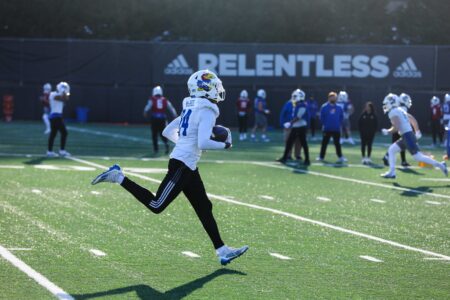Timing right for Mike Leach
If a big, fast, hard-hitting cornerback who was known as a handful off the field in high school had instead been an Eagle Scout, he would have played his college football at Texas or Oklahoma.
With other big, fast, hard-hitting cornerbacks as options, Texas and Oklahoma didn’t have to pursue Aqib Talib. Kansas University needed to take a chance on him, and, at least on the football field, it worked out extremely well for the Jayhawks.
Talib’s off-the-field issues continued at Kansas and into the NFL, but the Jayhawks don’t get to the Orange Bowl, never mind win it, without his All-American play.
Similarly, Mike Leach’s off-the-field issues — multiple lawsuits he has filed — don’t necessarily have to scare off Kansas just because they reportedly kept Maryland from pulling the trigger.
But it takes two to tango. Should Leach want the job at Kansas, which in the past five seasons has posted records of 12-1, 8-5, 5-7, 3-9 and 2-10, a gradual decline from national spotlight to local irrelevance? Yes.
The longer a football coach stays out of the game, the more difficult it will become to land a BCS job. This one comes with the bonus of facing Texas Tech every season. He’s only human, and as badly as he’d like to beat the Red Raiders in a court of law, that can’t compare to the satisfaction Leach could get from beating them on the football field.
His candidacy never will get hotter than it is now, so he might as well jump.
It pays to remember that those who do the hiring seem to forget former coaches quickly and put too way much emphasis on a coach’s age. Even Bill Snyder’s return to Kansas State was greeted with a near-universal roll of the eyes. Snyder, 72, has his team ranked 11th in the BCS standings.
Terry Donahue, a remarkably youthful 67, might be open to returning to college coaching if someone picked up the phone and asked the most underrated coach of the 20th century if his time in the broadcast booth has whetted his appetite for a return to the field. Phillip Fulmer, 61, coached Tennessee to a 13-0 season and national championship in 1998 and went 152-52. He wanted the KU job two years ago, didn’t get that offer and somehow remains on the market.
And what in the world is Glen Mason doing broadcasting when he should be coaching? That question so nagged me I decided to tap a connection to get him on the phone.
He wants to coach.
“I’m a coach,” Mason said by phone. “Everybody still calls me ‘coach.’ ‘Coach, when are you going back to coaching?’ People have called me about jobs, but not from a place I’d want to be at this point in my career. But there are a lot, lot, lot of places I’d like to go coach.”
Given his record of resurrecting sinking programs at Kent State, Kansas and Minnesota, why isn’t he mentioned as short-list candidate for a number of BCS jobs?
“Maybe I haven’t gone about it correctly,” Mason said. “I’m 61, but I’m a young 61.”
He has worked for the Big Ten Network the past five years, and that time has done nothing but make him even more convinced he could take another losing program and turn it into a winner.
“Sometimes a coach is too close to the trees and can’t see the forest,” Mason said. “I’ve been able to step back and see what guys have done. I’ve had a chance to evaluate what I did. There are a lot of bad coaches out there, I can tell you that. I’m not trying to act like a typical fan sitting in the stands, but there are times I’m thinking, ‘Geez, what are they doing?'”
And there are other times, Mason said, when he develops deep respect for coaches. He singled out Northwestern’s Pat Fitzgerald.
“When he first got the job, I thought he wasn’t ready for it,” Mason said. “I’ve watched him grow as a coach. The limitations he has to work with at Northwestern are unbelievable. The facilities are terrible, and with the academic restrictions he’s under, he’s done a fabulous job.”
It figures Mason would have a particular fondness for a coach who wins at place most don’t. Mason made a habit of it.
I’ve often wondered how much simple research athletic directors do when compiling short lists. I crunched some numbers on Mason’s career and it took all of 15 minutes. Does the average AD invest that much time or does he spend all his energy trying to figure out what coach will win the introductory news conference?
Here’s what the research shows:
At Kent State, Mason’s predecessor, Dick Scesniak, had a .242 winning percentage. Mason’s successor, Dick Crum, did even worse (.212). Mason’s winning percentage was .545.
At Kansas, Mason’s predecessor, Bob Valesente had a .205 success rate. Mason’s successor, Terry Allen, had a .379 winning percentage. Mason’s was .466. (Mark Mangino had a .506 mark at Kansas; his predecessor, Allen, .379; his successor, Turner Gill, a .208 winning percentage.)
At Minnesota, Mason’s predecessor, Jim Wacker, had a .291 success rate. Mason’s successor, Tim Brewster, batted .333. Mason’s winning percentage was .529.
Numbers for the three schools combined: Predecessors .259, successors .321, Mason .504.
No wonder he won conference coach-of-the-year honors in three different leagues. Yet Mason, who has a clean compliance record and brings no baggage, hasn’t yet been able to parlay those impressive turnarounds into one more job. Penn State and Illinois ought to bring him in for an interview, and Memphis should do the same with Mangino. They’re too good to be forgotten.
Leach did a terrific job at Texas Tech, but each year he spends away from the game, the less his success will matter to those who do the hiring.







